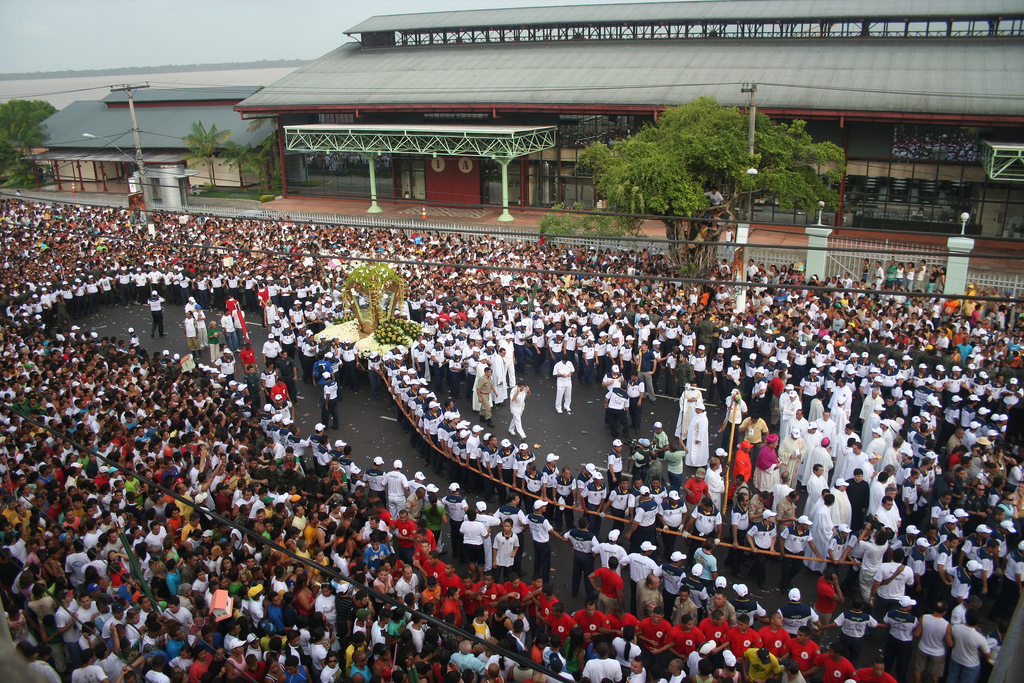Brazil comes by its reputation for a great party honesty–here are even more festas celebrated annually throughout the country.
Don’t miss Unique Festivals Throughout Brazil Part 1.
Even bigger and more spectacular than Carnaval are the not-to-be-missed Bumba-Meu-Boi festivities, which take place in June. São Luís is the definitive place to observe one of the country’s most captivating spectacles. Drawing on indigenous, African, and Portuguese folk elements, Bumba-Meu-Boi consists of a series of theatrical dances performed over several nights in mid-late June. The visually stunning festivities feature troupes of well-known folk characters in brilliant costumes accompanied by musicians playing brass instruments and drums, the most unique of which is the deep, throbbing bumba.
![Bumba-meu-boi. Photo © Secretaria de Cultura e Turismo de Santo Amaro-Ba (Own work) [<a href="http://creativecommons.org/licenses/by-sa/4.0">CC BY-SA 4.0</a>], <a href="https://commons.wikimedia.org/wiki/File%3ABumba-meu-boi_em_Santo_Amaro_-_Bahia.jpg">via Wikimedia Commons</a>.](https://www.holidaytravel.cc/Article/UploadFiles/201602/2016021615015456.jpg)
Bumba-meu-boi. Photo © Secretaria de Cultura e Turismo de Santo Amaro-Ba (Own work) [CC BY-SA 4.0], via Wikimedia Commons.
The festa revolves around the magical tale of a plantation owner who leaves a slave to take care of his prize bull (boi), which dies and then comes back to life with the help of forest spirits. Bumba-Meu-Boi troupes are like samba schools. There are many groups within the city, and rivalries exist as to who can put on the most dazzling spectacle featuring the story’s characters. The bois are exceptionally resplendent—their costumes are festooned in ribbons, sequins, and embroidery fanciful enough to make a Parisian couturier’s jaw drop. It’s impossible to resist joining in the dancing and singing that invades the streets of Praia Grande and Centro. If you miss the main celebration, you can catch Bumba-Meu-Boi troupes performing throughout the month of July at the Convento das Mercês.One of the biggest, most spectacular festivals in Brazil is Círio de Nazaré, held the second Sunday of October. Millions of Paraenses throng the streets of Belém to join in the procession carrying the statue of Nossa Senhora de Nazaré from the Catedral da Sé to the Basílica de Nazaré.

Círio de Nazaré in Belém. Photo © Celso Abreu, licensed Creative Commons usage.
Considered the patron saint of all Paraenses and protectress of Belém, the cult of Nossa Senhora de Nazaré dates back to 1700, when a caboclo named Plácido found a statue of the Virgin lying in a creek located in the present-day bairro of Nazaré. Plácido took the statue home with him. But when he woke up the next morning, he was astonished to discover that it had returned to its original spot. After taking the statue home once again, it reappeared at the creek. The amazed caboclo built a small chapel (later replaced by the Basílica de Nazaré) to house the Virgin. Word of the miracle got around, and pilgrims and supplicants from all over Pará came seeking Nossa Senhora’s blessing and divine intervention.
By the end of the 1700s, her popularity had become so great that a public festa, the Círio de Nazaré, was organized so that the entire city could pay homage to the Virgin. The first procession took place in 1793. The image of Nossa Senhora de Nazaré, splendidly arrayed and covered in flowers, was carried in a chariot through the muddy streets by bulls. By the 20th century, Belém’s streets had become paved and bulls were no longer necessary. Instead, the thick rope attached to the carriage—measuring 350 meters (1,150 feet)—was now pulled by penitents who, to this day, jostle ferociously for the chance to grip their hands around the rough sisal and literally bleed—by the procession’s end, there is blood in the streets—for the honor of transporting the Virgin.
Although the Sunday procession constitutes the most important event, the festa actually kicks off on Friday afternoon with Nossa Senhora de Nazaré’s departure from the Basílica to a church in the nearby town of Ananindeua. As the Virgin glides by in an open car, Belenenses hovering in decorated windows and spilling into the streets toss rose petals and confetti. The following dawn, the Virgin once again takes to the road, this time in an open truck surrounded by a cavalcade of cars and motorcycles, en route to the town of Icoaraci. Here, the image is loaded onto a spectacularly decorated boat. Since Nossa Senhora de Nazaré is also the patron saint of river navigators, the Virgin’s crossing of the Rio Guamá to Belém is accompanied by a fleet of hundreds of festively adorned wooden boats. This river spectacle is best viewed from the ramparts of the Forte do Presépio.
The Virgin’s arrival in Belém is greeted with a fireworks display. Much merrymaking then ensues throughout the Cidade Velha, lasting all night, until the climactic procession that takes place on Sunday morning. The Virgin’s return to the Basílica is usually completed by midday. Afterward, people get together with family and friends and feast on favorite dishes, such as pato no tucupi and maniçoba. If you want to be in town for Círio, make sure to book a hotel far in advance.
Excerpted from the Fourth Edition of Moon Brazil.